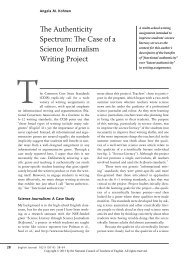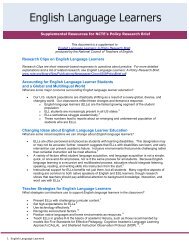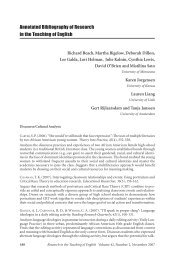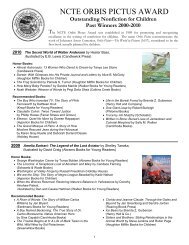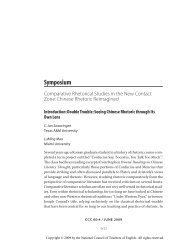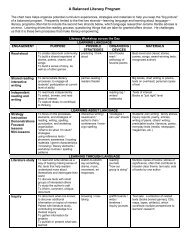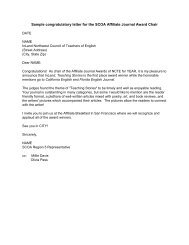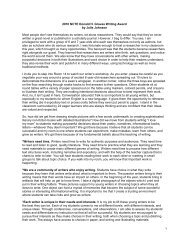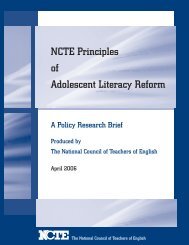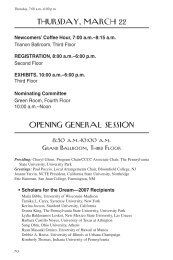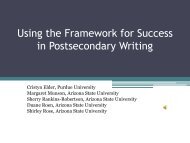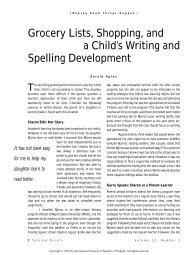Annotated Bibliography of Research in the Teaching of English
Annotated Bibliography of Research in the Teaching of English
Annotated Bibliography of Research in the Teaching of English
- No tags were found...
Create successful ePaper yourself
Turn your PDF publications into a flip-book with our unique Google optimized e-Paper software.
<strong>Annotated</strong> <strong>Bibliography</strong> 237VORDERER, P., & BRYANT, J. (EDS.). (2006). Play<strong>in</strong>g video games: Motives, responses, and consequences.Mahwah, NJ: Erlbaum.Writ<strong>in</strong>gCRAGG, L., & NATION, K. (2006). Explor<strong>in</strong>g written narrative <strong>in</strong> children with poor read<strong>in</strong>g comprehension.Educational Psychology, 26(1), 55-72.Exam<strong>in</strong>es <strong>the</strong> spell<strong>in</strong>g performance and <strong>the</strong> narrative writ<strong>in</strong>gs <strong>of</strong> 10-year-old poorcomprehenders. F<strong>in</strong>ds that poor comprehenders and control children did not differ <strong>in</strong> spell<strong>in</strong>gability. Poor comprehenders produced narratives <strong>of</strong> similar length and syntactic complexity tocontrol children. However, poor comprehenders’ narratives captured less <strong>of</strong> <strong>the</strong> story contentand conta<strong>in</strong>ed a less sophisticated story structure than those <strong>of</strong> control children.FISHMAN, J., LUNSFORD, A., & MCGREGOR, B. (2005). Perform<strong>in</strong>g writ<strong>in</strong>g, perform<strong>in</strong>g literacies.College Composition and Communication, 57(2), 224-252.Tracks 189 Stanford students’ writ<strong>in</strong>g for two years as part <strong>of</strong> a five-year Stanford Study <strong>of</strong>Writ<strong>in</strong>g. Between <strong>the</strong> first and second years, changes <strong>in</strong> <strong>the</strong> k<strong>in</strong>ds <strong>of</strong> student writ<strong>in</strong>g reflectedshifts towards a focus on more discipl<strong>in</strong>ary-specific assignments, but <strong>the</strong>ir self-confidence aswriters decl<strong>in</strong>ed dur<strong>in</strong>g <strong>the</strong> first year but <strong>the</strong>n rebounded by <strong>the</strong> end <strong>of</strong> <strong>the</strong> second year. Over<strong>the</strong> two years, students generated extensive digital writ<strong>in</strong>g both outside and with<strong>in</strong> classes, develop<strong>in</strong>ga strong <strong>in</strong>terest <strong>in</strong> perform<strong>in</strong>g self-sponsored writ<strong>in</strong>g. Highlights two students’ performances<strong>of</strong> texts that represent <strong>the</strong> <strong>in</strong>creas<strong>in</strong>g importance <strong>of</strong> performance <strong>of</strong> digital writ<strong>in</strong>gfor audiences outside <strong>the</strong> classroom.GALBRAITH, D., FORD, S., WALKER, G., & FORD, J. (2005). The contribution <strong>of</strong> different components<strong>of</strong> work<strong>in</strong>g memory to knowledge transformation dur<strong>in</strong>g writ<strong>in</strong>g. L1 – Educational Studies<strong>in</strong> Language and Literature, 5(2), 113-145.Exam<strong>in</strong>es how ideas are developed dur<strong>in</strong>g outl<strong>in</strong><strong>in</strong>g and how this is related to <strong>the</strong> quality <strong>of</strong> <strong>the</strong>result<strong>in</strong>g text. F<strong>in</strong>ds that <strong>the</strong> beneficial effect <strong>of</strong> plann<strong>in</strong>g on text content depends on two factorsthat <strong>in</strong>dicated knowledge transform<strong>in</strong>g activities: (1) <strong>the</strong> extent to which new ideas are<strong>in</strong>troduced dur<strong>in</strong>g <strong>the</strong> organizational phase <strong>of</strong> plann<strong>in</strong>g, and (2) <strong>the</strong> extent to which rhetoricalgoals are <strong>in</strong>corporated <strong>in</strong> plann<strong>in</strong>g. Relatively less experienced writers show much less <strong>of</strong> <strong>the</strong>seactivities dur<strong>in</strong>g plann<strong>in</strong>g. Provides implications for education.GRAHAM, S., HARRIS, K. R., & MASON, L. (2005). Improv<strong>in</strong>g <strong>the</strong> writ<strong>in</strong>g performance, knowledge,and self-efficacy <strong>of</strong> struggl<strong>in</strong>g young writers: The effects <strong>of</strong> self-regulated strategy-development.Contemporary Educational Psychology, 30(2), 207-241.Exam<strong>in</strong>es whe<strong>the</strong>r Self-Regulated Strategy Development (SRSD) is effective for improv<strong>in</strong>g <strong>the</strong>writ<strong>in</strong>g, knowledge <strong>of</strong> writ<strong>in</strong>g, and self-efficacy <strong>of</strong> struggl<strong>in</strong>g, 3rd-grade writers. The <strong>in</strong>structionfocuses on learn<strong>in</strong>g writ<strong>in</strong>g strategies and knowledge for plann<strong>in</strong>g and compos<strong>in</strong>g storiesand persuasive essays. F<strong>in</strong>ds that SRSD had a positive impact on students’ writ<strong>in</strong>g performanceand knowledge about writ<strong>in</strong>g. Peer support was found to enhance transfer to un<strong>in</strong>structedgenres.GRISHAM, D. L., & WOLSEY, T. D. (2005). Improv<strong>in</strong>g writ<strong>in</strong>g: Compar<strong>in</strong>g <strong>the</strong> responses <strong>of</strong> eighthgraders,preservice teachers and experienced teachers. Read<strong>in</strong>g & Writ<strong>in</strong>g Quarterly, 21(4), 315-330.Exam<strong>in</strong>es how middle-school students and teachers <strong>in</strong> preservice and Master <strong>of</strong> Arts classesanalyzed and scored <strong>the</strong> same set <strong>of</strong> writ<strong>in</strong>gs <strong>in</strong> small-group evaluations. F<strong>in</strong>ds that studentsand teachers evaluated <strong>the</strong> writ<strong>in</strong>gs similarly. Concludes that <strong>the</strong>re is general agreement aboutwhat constitutes good writ<strong>in</strong>g, and that evaluation <strong>of</strong> writ<strong>in</strong>g may provide an <strong>in</strong>structionalentry for teachers.



